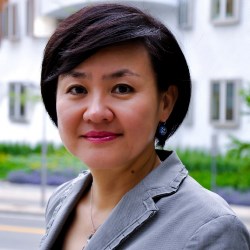
About
Li-Huei Tsai received her Ph.D degree from the University of Texas Southwestern Medical Center at Dallas. Dr. Tsai completed her postdoctoral work at Cold Spring Harbor laboratory and Massachusetts General Hospital. In 1994, Dr. Tsai joined the faculty in the Department of Pathology at Harvard Medical School and was named an investigator of Howard Hughes Medical Institute in 1997. In 2006, she was appointed Professor in the Department of Brain and Cognitive Sciences, and joined the Picower Institute for Learning and Memory at MIT. Since 2009, Dr. Tsai has served as the Director of the Picower Institute for Learning and Memory.
Research
Our laboratory is interested in elucidating the pathogenic mechanisms underlying neurological disorders that impact learning and memory. We take multidisciplinary, network-level approaches to decipher the molecular, cellular, and circuit basis of neurodegenerative disorders.
1) Transcriptomic and epigenomic analysis of brain disorders.
We are currently interested in understanding the transcriptomic and epigenomic landscape in the major brain cell types in both normal physiological brain function and under pathological disease states. In parallel work, we are examining the role of genomic integrity in the development of age-related neurological disorders.
2) Systems level analysis of neurodegeneration.
Cognitive deficits that occur in neurodegeneration may arise from an accumulation of altered cellular processes that lead to disruptions in neural circuits and network connectivity. In particular, oscillations in the gamma frequency range (between 30-80 Hz) are associated with higher order brain functions, and may be disrupted in the early stages of AD in human patients as well as in mouse models. We are thus interested in applying circuit manipulations to ameliorate cognitive deficits in AD. Through the targeted application of optogenetic and chemogenetic tools, we also aim to manipulate the activity of specific neural populations and circuits to gain insights at the intersection of pathology, network activity, and behavior. Additionally, we are mapping out the sequential temporal and spatial disruptions of neural circuits by the deposition of amyloid and aggregated tau protein in AD, to identify nodes of vulnerability and to understand how these pathologies propagate throughout the brain.
3) Using human induced pluripotent stem cells (iPSCs) and tissue bioengineering to model Alzheimer’s disease and Down syndrome.
Our lab has generated numerous iPSC lines by reprogramming fibroblasts from healthy individuals, as well as from late onset sporadic Alzheimer’s disease (LOAD), early onset familial AD (fAD), and Down syndrome patients. To assess the phenotypic consequences of disease-associated genetic variants, we additionally apply the CRISPR/Cas9 genome-editing technique to create isogenic cell lines, as well as genome-engineering approaches such as the dCAS9 system to examine the impact of non-coding genetic variants of AD on gene expression. In addition to conventional 2D cultures, the Tsai Lab is also developing and utilizing complex culture systems in 3D and with multiple cell types in co-culture. Using techniques of bioengineering combined with multiphoton deep imaging, optogenetics, and electrophysiology, we can recapitulate and study complex in vitro models of human brain tissue.
Teaching
9.013J Molecular and Cellular Neuroscience Core I
Publications
Iaccarino HF, Singer AC, Martorell AJ, Rudenko A, Gao F, Gillingham TZ, Mathys H, Seo J, Kritskiy O, Abdurrob F, Adaikkan C, Canter RG, Rueda R, Brown EN, Boyden ES, Tsai L-H. (2016). Gamma frequency entrainment attenuates amyloid load and modifies microglia. Nature. 2016 Dec 7; 540 (7632): 230-235. Doi: 10.1038/nature20587. PMID: 27929004.
Lin YT, Seo J, Gao F, Feldman HM, Wen H, Penney J, Cam HP, Gjonetska E, Raja W, Cheng J, Rueda R, Kritskiy O, Abdurrob F, Peng Z, Milo B, Yu CJ, Elmsaouri S, Dey D, Ko T, Yankner B and Tsai L-H. (2018). APOE4 causes widespread molecular and cellular alterations associated with Alzheimer’s disease phenotypes across human iPSC-derived brain cell types. Neuron, 2018 Jun 27; 98 (6):1294. Doi: 10.1016/j.neuron.2018.06.011. PMID: 29953873.
Martorell A, Paulson AL, Suk H, Adurrob F, Drummond G, Gian W, Young J, Kim D, Kritskiy O, Barker S, Mangena V, Prince SM, Brown EN, Chung KC, Boyden ES, Singer AC, Tsai L-H. Multi-sensory gamma stimulation ameliorates Alzheimer’s-associated pathology and improves cognition. Cell. 2019 177(2), 256-271. PMID: 30879788.
Mathys H, Davila-Velderrain J, Peng Z, Gao F, Mohammadi S, Young JZ, Menon M, He L, Abdurrob F, Jiang X, Martorell AJ, Ransohoff RM, Hafler BP, Bennett DA, Kellis M, Tsai L-H. Single-cell transcriptomic analysis of Alzheimer’s disease. Nature, May 1. doi: 10.1038/s41586-019-1195-2. PMID: 31042697.
Adaikkan C, Middleton SJ, Marco A, Pao PC, Mathys H, Kim DNW, Gao F, Young JZ, Suk HJ, Boyden ES, McHugh TJ, Tsai, L-H. Gamma entrainment binds higher order brain regions and offer neuroprotection. Neuron, May 2. doi: 10.1016/j.neuron.2019.04.011. PMID: 31076275.

